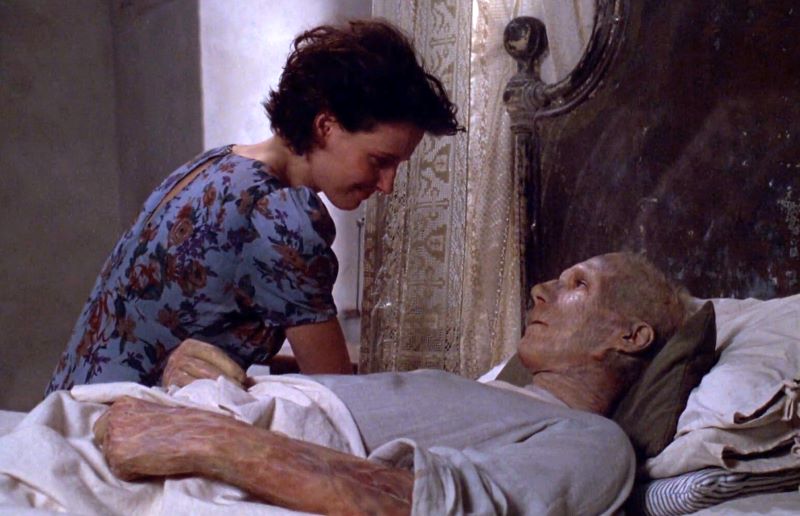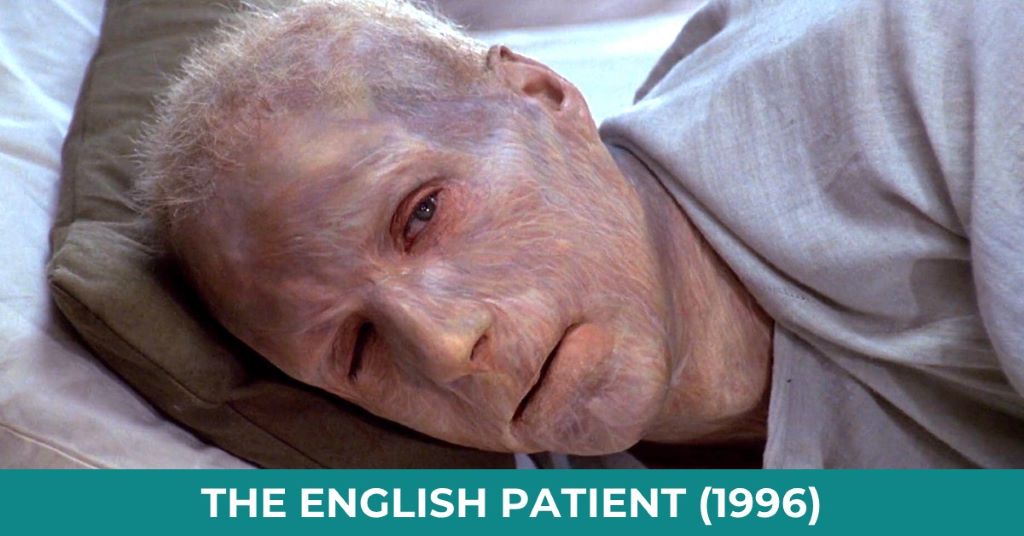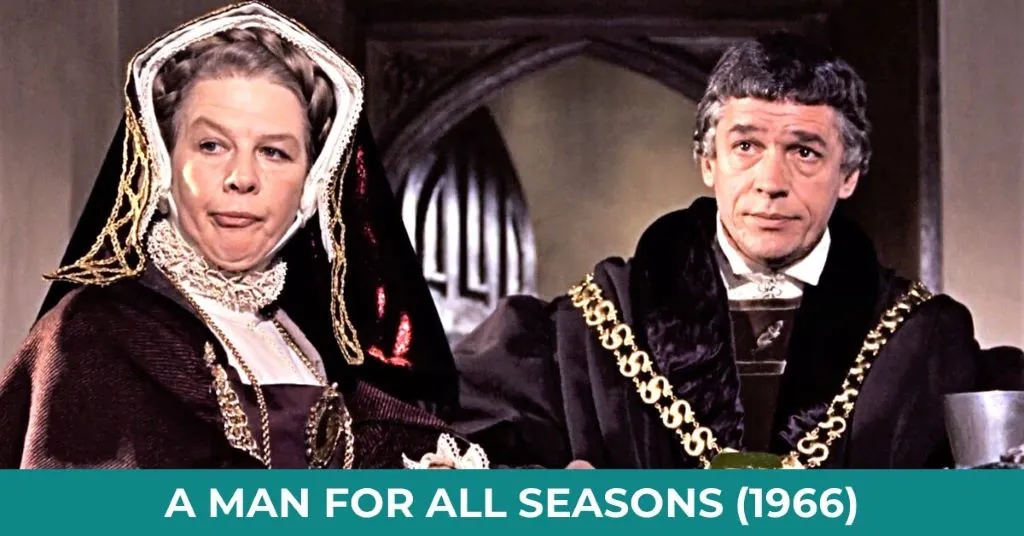Last updated on September 18th, 2023 at 10:44 pm
The English Patient is a romantic war drama film of 1996 based on the life of the Hungarian cartographer Laszlo Almasy who fell in love with a British explorer, Katherine during World War II. The film portrays how Almasy had to pay a hefty price for falling in love with the wife of a British explorer, Geoffrey Clifton, who wanted to kill him with a double suicide attempt with his biplane crash, during their expedition in Kufra Oasis. It also shows how Almasy’s British accepted English and last name made him a suspect of being a spy to the Allies and the Germans.
Based on the novel of the same name written by Michael Ondaatje, The English Patient is directed by Anthony Minghella and starring Ralph Fiennes, Juliette Binoche, and Kristin Scott Thomas. The English Patient won 58 awards from various organisations and received critical acclaim and won nine Academy Awards, including Best Picture. It is the American Film Institute’s 56th of 100 best films of 100 years and 55th greatest films of 100 by the British Film Institute and one of 101 best films on my review list.
In this article, we will explore the plot, characters, themes, cinematography, music, impact on the film industry, criticism, and controversy surrounding the movie, as well as its legacy, box office, and financial success.
Historical Background
The English Patient is a 1996 film directed by Anthony Minghella, based on the novel of the same name by Michael Ondaatje. The film is set in the backdrop of World War II and follows the story of four characters: a Canadian nurse, Hana, a Sikh British Army and combat engineer, Kip, a Canadian thief, Caravaggio, and the titular character, a badly burned and unidentifiable patient who is under Hana’s care in an abandoned Italian monastery.
The film is set in 1945, at the end of the war, but it also features flashbacks to the 1930s and 1940s, highlighting the events that led to the characters being in the monastery. The English Patient is revealed to be a Hungarian cartographer and explorer named Count László de Almásy, who had been part of a British spy mission in North Africa during the war.
The film deals with themes of love, war, betrayal, identity, and the human condition. It was critically acclaimed and won nine Academy Awards, including Best Picture, Best Director, and Best Supporting Actress for Juliette Binoche, who played Hana.
The English Patient is set during a tumultuous time in world history, with World War II coming to an end and the aftermath of the conflict being felt around the globe. The film also explores the tensions and complexities of colonialism, as well as the role of individuals in larger historical events.
Plot Summary
The English Patient is set during World War II and follows the story of an injured Hungarian cartographer, Count László de Almásy (Fiennes), who is being taken care of by a nurse, Hana (Binoche), in an abandoned Italian monastery. Almásy is burned beyond recognition and cannot remember his past. Through a series of flashbacks, the movie tells the story
In 1945, a badly burned pilot was rescued and brought to Royal Canadian Army Medical Corps by a group of Bedouins after embalming where his name was known as Almasy, played by Ralph Fiennes. He cannot remember his nationality, but because of his British Accented English, was enlisted as English Patient in Italy. Hana, played by Juliette Binoche, a French-Canadian combat nurse decided to look after Almasy and was transported to a bombed and deserted Church.
As time progressed, Hana was told through his flashback his history of what and how caused him the injury. Almasy’s only possession was a copy of Herodotus’ Histories, with personal notes, pictures, and mementoes kept inside. they were soon joined by Lt. Kip, (played by Naveen Andrews) a Sikh sapper in the British Indian Army posted with Surgent Hardy to clear German mines and booby traps. a Canadian Intelligence Corps and an Allies spy in Cairo, David Caravaggio (played by Willem Dafoe), also followed them after killing his German torturer and the photographers to take his pictures.

Caravaggio came to kill Almasy on the suspicion that he was the one who provided the Germans with maps to infiltrate Africa. Almasy releveled gradually reveals his past through a series of flashbacks. However, over the days of the patient relating his story, Hana and Kip developed a love affair.
Almasy revealed that he came to the Egyptian desert in 1939 as the British Government ordered the expedition as a member of the Royal Geographical Society, who was in fact a Hungarian cartographer named László Almásy. With him were Englishman Peter Madox, and British couple Geoffrey and Katharine Clifton, who own a plane and contribute with aerial surveys.
With the help of Bedouin, Almasy discovered the Cave of Swimmers, an ancient site of cave paintings. Katherine and Almasy fell in love while documenting the find. Katherine found his notes bearing feeling toward her while she was pasting two cave images inside his book she drew from inside the cave.
Back in Cairo, they united in his hotel room when the group discussed the detailed on archaeological surveys of the cave and the surrounding area, though discovered by her husband later. But after some months, Katharine stopped the affair for fear Geoffrey will discover it. Nevertheless, shortly afterwards the archaeological projects are halted due to the onset of the war prompting Madox to leave his Tiger Moth aeroplane at Kufra Oasis before his return to Britain.
To Caravaggio Almasy said that he killed Geoffrey and Katherine because he loved her. he said that one day in 1941 Almay was waiting after packing camp for Geoffrey to return for him with his biplane. But Geoffrey, carrying Katherine in the front seat, dove straight for Almásy with the intention to kill, who jumps out of the way. The crash killed Geoffrey making Katharine badly injured. She revealed to him tath Geoffrey knew about their affair, and was attempting a double murder-suicide. Almásy carried Katherine to the Cave of Swimmers where he left her alone for El Taj promising to return.
Leaving her in the cave with provisions and his book, Almásy walks three days cross-desert to arrive at British-held El Tag. But in the hit of the moment, while explaining the desperate situation and asking for help, a young officer detains Almásy on suspicion of being a spy because of his unusual last name. they thought of a German spy and was being transported to Benghazi.
He killed a British guard on the train when was taken to the bathroom and jumped off the train. The British did not believe him because of his name. assisted by the Germans he reached the cave. he traded the maps of the expedition for fuel.
The German took him to the Kufra Oasis, where Madox has hidden his plane. Katherine died already by the time Almasy reached the cave for her. With German fuel and the British plane, he decided to carry her body to Britain. Unfortunately, while still over the desert with the plane the German soldiers shot down it causing him to burn him badly. Caravaggio decided not to kill Almasy after hearing his story.

The film ends as Almasy told Hana that he has had enough and asked her to push 6 ampoules of morphine at a time. Reposted, Kip deserted the place close to the church promising Hana to reunite. Though visibly upset, she agreed to Lamsy’s wish to be administered a lethal dose. She read him Katharine’s final letter as he slowly closed his eyes. The next morning Caravaggio returned with a friend, and they get a lift to Florence. Hana holds Almásy’s book tightly as they rode away with others.
Analysis of the Characters
The characters in The English Patient are multifaceted and multi-dimensional, each with their own drives and expectations. Almásy is the protagonist of the movie and is portrayed as a flawed and conflicted individual who is a passionate and intelligent man deeply in love with a married woman, Katharine Clifton, wife of Geoffrey Clifton. Almásy’s love for Katharine drives much of the plot of the movie, and his quest to find her after she is presumed dead in the Cave of Swimmers serves as the movie’s main conflict.
Katharine Clifton, the object of Almasy’s affection, is also a complex character. She is married to a British explorer, Geoffrey Clifton, but falls in love with Almasy during a desert expedition. Katharine’s love for Almasy is forbidden and dangerous and ultimately leads to tragedy.
Katherine was so consumed by love for him that, when she went to meet Almasy in his hotel room in Cairo, she slapped him hard in the face before they both gave in to making love. She risked being watched by her husband who eventually noticed their consort and tried to kill three of them by crashing the biplane only to kill him injuring Katherine badly. Heartbreaking to see how she died in the cave, alone in the dark waiting for Almasy to return from Al Taj with a doctor and a vehicle.
Had she fallen in love with him, she would not have decayed in the dungeon. Being in the desert was hard for her who longed to be back in England where there is green available. Her love for Almasy killed her husband, herself and eventually her lover, too. To love is to beget adversaries. Making the film memorable, Katherine announced, “I think it is all a matter of love: the more you love a memory, the stronger and stranger it becomes.”
Almasy’s attachment to Herodotus is amazing, he never let go of his book. I like when Hana read the note from the past from the book, “Betrayals in war are childlike compared with our betrayals during peace. New lovers are nervous and tender but smash everything. For the heart is an organ of fire.” And “Love is not love which alters when it alteration finds.”
Hana, the nurse who decided to take care of Almasy, is also a complex character. She is dealing with her own trauma from the war whose boyfriend, captain McGan died and is trying to find meaning and purpose in her life. Hana develops a strong bond with Almasy and becomes emotionally attracted to his story while falling in love with Kip, even as she struggles to come to terms with her own feelings.
The core purpose of nursing was revealed when Hana was asked by Almasy why she is so determined to save him. “Because I am a nurse” she replied.
Moreover, wonderful is the character of Caravaggio, the Allies’ spy who traced down Almasy with the intention to kill after killing his German torturer and the man who took his photographs. Caravaggio thought Almasy was the one behind the Germans finding their way to Cairo until the very last moment.
Themes Explored
The English Patient presents a couple of themes, including love, betrayal, and identity. The movie portrays love as a powerful and all-consuming force that can drive individuals to great heights of passion and desperation. Almasy’s love for Katharine is all-consuming, and she was willing to risk everything to be with her.
Betrayal is another theme explored in the movie, especially, Almasy betrayal with Geoffrey Clifton, by having an affair with Katharine. Katharine, in turn, betrays her husband by pursuing a relationship with Almasy. These betrayals have tragic consequences and ultimately lead to the death of the trio.
Identity is also a central theme in The English Patient. Almasy’s identity is called into question as he struggles to remember his past and come to terms with his injuries. Hana is also struggling to define her identity as she tries to find purpose and meaning in a world torn apart by war.
Cinematography
The cinematography in The English Patient is breathtaking and helps to create a dreamlike and atmospheric mood throughout the movie. The movie was filmed in a number of locations, including Italy and Tunisia, and the desert landscapes are particularly stunning. The filming of the desert and the life of the desert and sand storm is fascinating, which I have never seen, except in Lawrence of Arabi.
The use of lighting and colour is also notable in the movie. The scenes set in the monastery are lit with soft, muted colours that give the movie a nostalgic and melancholic texture. The scenes set in the desert are filled with vibrant yellows and oranges that create a sense of warmth and energy.
The use of camera angles is also effective in the movie. The camera is often positioned at a low angle to capture the vastness and emptiness of the desert landscape. This creates a sense of isolation and loneliness that reflects the characters’ emotional states.
Impact on the Film Industry
The English Patient had a significant impact on the film industry, both in terms of its critical reception and its influence on other movies and filmmakers. The movie was a critical and commercial success, winning nine Academy Awards and grossing over $230 million worldwide. It was praised for its breathtaking cinematography, complex characters, and beautiful score.
The movie also had a significant impact on other filmmakers, who were inspired by its storytelling techniques and visual style. Director Christopher Nolan has cited The English Patient as an influence on his movie Dunkirk, which also explores the themes of war and identity.
The English Patient is also notable for its portrayal of love and desire, which is both passionate and tragic. The movie explores the idea that love can be a force for good, but can also lead to destruction and heartbreak.
Overall, The English Patient is a stunning cinematic achievement that explores complex themes and features breathtaking visuals and music. It is a testament to the power of storytelling and the impact that movies can have on audiences and filmmakers alike.
The Legacy of The English Patient
The English Patient has left a lasting legacy on the film industry and popular culture. The movie has inspired countless filmmakers and writers, and its themes and characters continue to resonate with audiences around the world.
One of the most significant legacies of The English Patient is its impact on the portrayal of love and desire in movies. The movie broke new ground by exploring the complexities of love and desire in a way that was both realistic and deeply moving. It showed that love can be both beautiful and destructive, and that desire can lead to both joy and heartbreak.
Another important legacy of The English Patient is its use of cinematography and music to create a truly immersive cinematic experience. The movie’s sweeping landscapes, intimate close-ups, and stunning visuals transport viewers to another time and place, while its haunting score by Gabriel Yared adds emotional depth and resonance to the story.
Finally, The English Patient has had a significant impact on the careers of the actors and filmmakers involved in its creation. Ralph Fiennes and Kristin Scott Thomas, in particular, became international stars after the movie’s release, and director Anthony Minghella went on to make several other acclaimed films before his untimely death in 2008.
In conclusion, The English Patient has left an indelible mark on the film industry and popular culture. Its exploration of love, desire, and identity, as well as its stunning visuals and music, continue to inspire and captivate audiences around the world.
Reception and Awards
Upon its release in 1996, The English Patient was met with widespread critical acclaim and commercial success. The movie received numerous awards and nominations, cementing its place as one of the most celebrated movies of the 1990s.
One of the most significant accolades that The English Patient received was the Academy Award for Best Picture. The movie also won Best Director for Anthony Minghella, Best Supporting Actress for Juliette Binoche, and Best Adapted Screenplay for Minghella. It was nominated for a total of 12 Oscars, making it one of the most nominated movies in history.
In addition to its success at the Academy Awards, The English Patient also won numerous other awards and honours. It won the Golden Globe for Best Motion Picture – Drama, as well as the BAFTA Award for Best Film. It also won awards at the Cannes Film Festival, the Berlin International Film Festival, and the National Board of Review.
The critical response to The English Patient was overwhelmingly positive. Critics praised the movie’s sweeping visuals, complex characters, and poignant storytelling. The movie was also praised for its portrayal of love and desire, which was both passionate and heartbreaking.
Despite its critical and commercial success, The English Patient has not been without its detractors. Some have criticized the movie for being overly melodramatic or self-indulgent, while others have criticized it for its portrayal of colonialism and imperialism.
Overall, however, The English Patient remains a beloved and influential movie that has stood the test of time. Its impact on the film industry and popular culture is undeniable, and its reception and awards are a testament to its enduring legacy.
Comparison to the Novel
The English Patient is a film adaptation of the novel by Michael Ondaatje, and as with most adaptations, there are significant differences between the book and the movie. While the movie remains faithful to the overall themes and characters of the novel, there are several key differences that distinguish the two works.
One of the most significant differences between the book and the movie is the way in which the story is told. The novel uses a non-linear narrative structure, with the story unfolding through a series of flashbacks and fragmented memories. In contrast, the movie tells the story in a more straightforward, chronological manner, with fewer flashbacks and a more linear narrative.
Another significant difference between the book and the movie is the way in which the characters are portrayed. While the movie remains true to the essential nature of the characters in the book, there are subtle differences in their personalities and motivations that distinguish the two works. For example, the movie places a greater emphasis on the love story between the English patient and Katharine, while the book explores a wider range of relationships and themes.
The ending of the book and the movie are also different. Without giving away any spoilers, it can be said that the ending of the book is more ambiguous and open to interpretation, while the movie provides a more definitive and emotional conclusion to the story.
Despite these differences, both the book and the movie share a common theme of love, loss, and the human experience. Both works are masterpieces in their own right, and the differences between them only serve to highlight the unique qualities of each medium.
In conclusion, The English Patient is a brilliant adaptation of Michael Ondaatje’s novel that remains faithful to the essential themes and characters of the book while also standing on its own as a masterpiece of cinema. The differences between the two works only serve to highlight the unique qualities of each medium, and both the book and the movie continue to captivate and inspire audiences around the world.
Analysis of the Ending
The ending of The English Patient has been the subject of much discussion and analysis among fans and critics alike. Without giving away any spoilers, the ending of the movie is both emotional and powerful, leaving a lasting impression on viewers long after the credits have rolled.
One interpretation of the ending is that it represents a moment of redemption for the characters. Throughout the movie, the characters struggle with issues of guilt, loss, and regret. The final scene of the movie can be seen as a moment of catharsis, as the characters find a measure of peace and closure.
Another interpretation of the ending is that it represents a commentary on the nature of memory and storytelling. Throughout the movie, the characters grapple with the fragility of memory and the subjective nature of truth. The final scene of the movie can be seen as a reflection on the power of storytelling to create meaning and purpose in our lives.
Regardless of how one interprets the ending, it is clear that the final scene of The English Patient is a powerful and memorable moment that leaves a lasting impression on viewers. It is a testament to the skill of the filmmakers and the power of cinema to capture and evoke complex emotions and ideas.
In conclusion, the ending of The English Patient is a powerful and emotionally resonant moment that has been the subject of much discussion and analysis. Whether one sees it as a moment of redemption for the characters or a commentary on the nature of memory and storytelling, it is clear that the final scene of the movie is a testament to the power of cinema to capture complex emotions and ideas.
Box Office and Financial Success
The English Patient was not only a critical success, but also a box office hit. The film was produced with a budget of $31 million and went on to gross over $230 million worldwide, making it one of the highest-grossing films of 1996.
The success of the movie can be attributed to several factors. First and foremost, the film had a stellar cast, including Ralph Fiennes, Juliette Binoche, and Kristin Scott Thomas. Their performances received critical acclaim and helped draw audiences to the movie theatres.
Secondly, the film was marketed as a sweeping romantic epic, complete with lush cinematography and a haunting musical score. This marketing strategy proved effective, as audiences flocked to theatres to experience the film’s sweeping beauty and poignant love story.
Finally, the film’s critical success also helped to drive its financial success. The English Patient received 12 Academy Award nominations and won nine, including Best Picture, Best Director, and Best Supporting Actress for Juliette Binoche. These accolades helped to create buzz and generate even more interest in the film.
Overall, the financial success of The English Patient is a testament to the film’s quality and the effectiveness of its marketing and critical reception. It is rare for a film to achieve both critical acclaim and financial success, but The English Patient managed to do just that, becoming one of the most beloved and enduring films of the 1990s.
Conclusion
The English Patient is a cinematic masterpiece that tells a powerful and emotional story of love, war, and redemption. The film’s stunning visuals, powerful performances, and masterful direction and storytelling have earned it a place in the pantheon of great films.
At its core, the film is a meditation on the nature of love and the ways in which it can endure even in the face of great hardship and tragedy. The story of Almasy and Katharine Clifton is a haunting and deeply moving one, and their love story is one that will stay with viewers long after the credits have rolled.
The English Patient is also a reflection on the devastating impact of war, both on the individuals who fight in them and on the world at large. The film’s depiction of the harsh realities of war is unflinching, and it serves as a reminder of the terrible toll that conflict can take.
Ultimately, The English Patient is a film that is both beautiful and profound, a work of art that explores some of the most fundamental aspects of the human experience. It is a testament to the power of cinema to move us, to inspire us, and to help us to understand the world around us in new and deeper ways.






